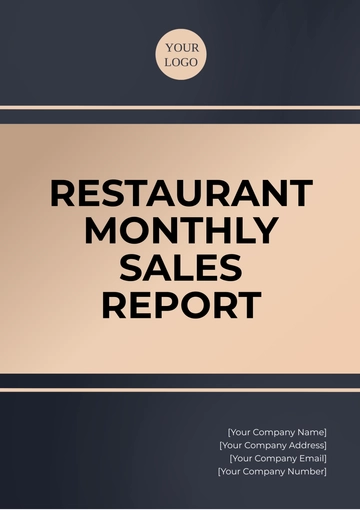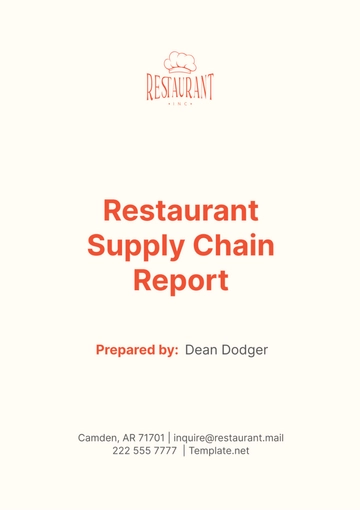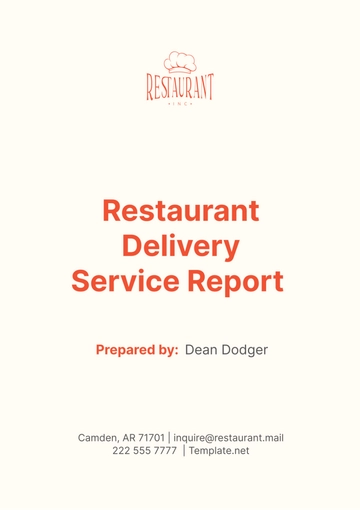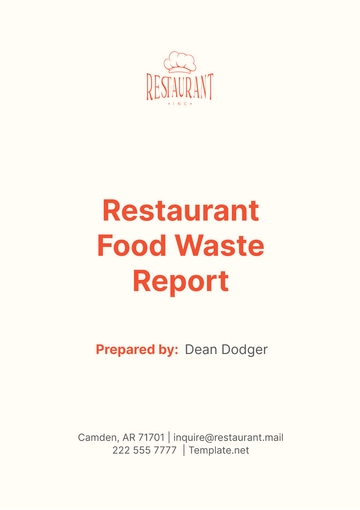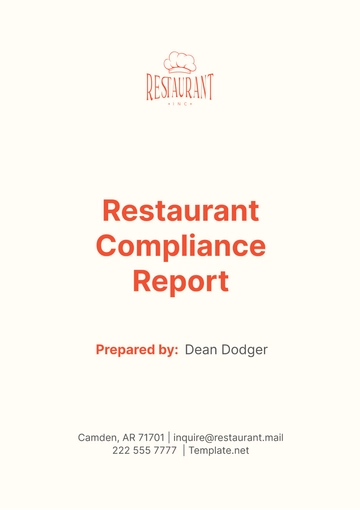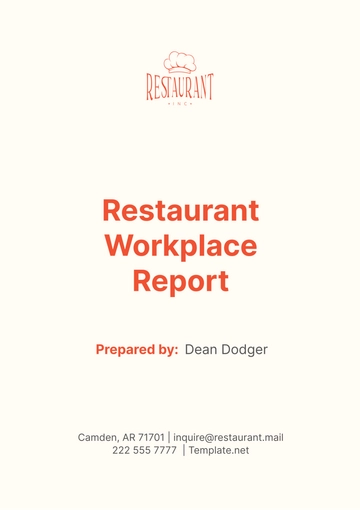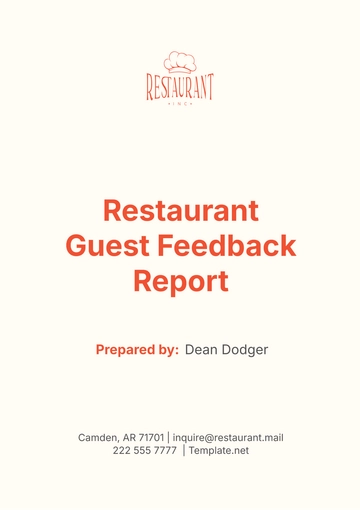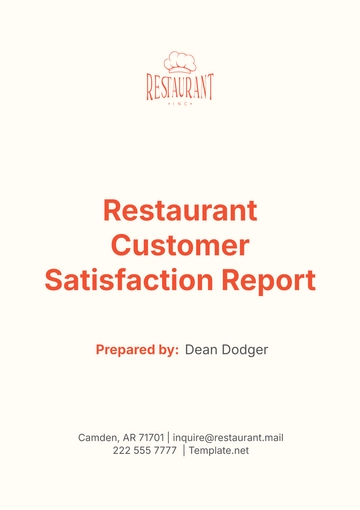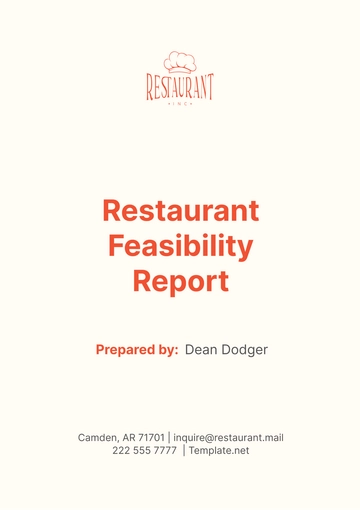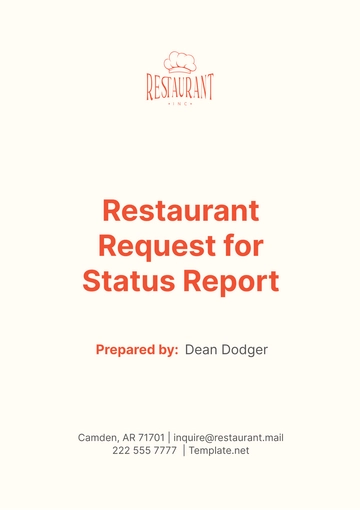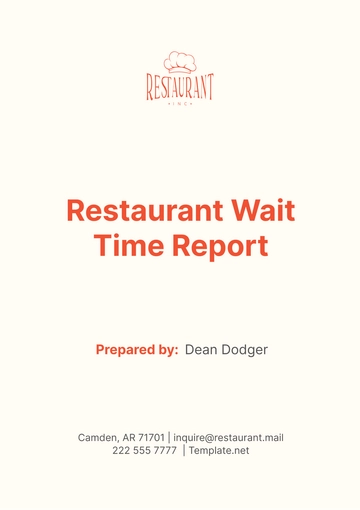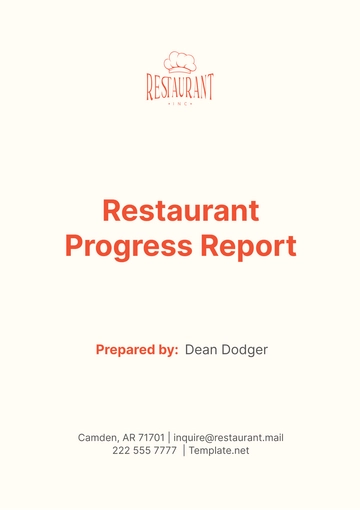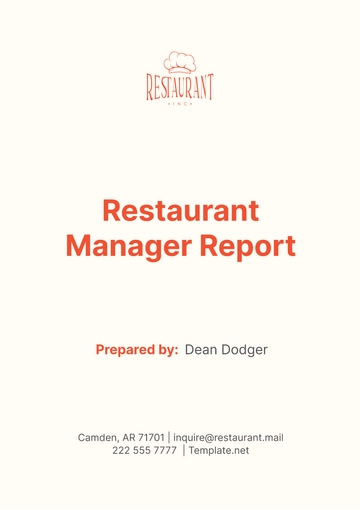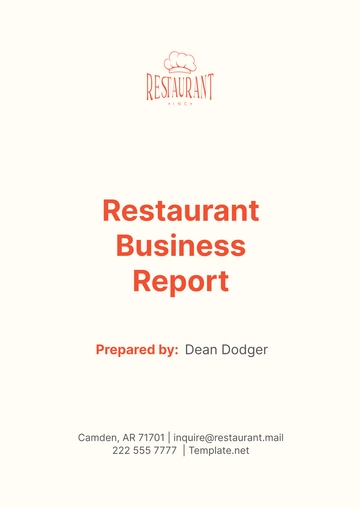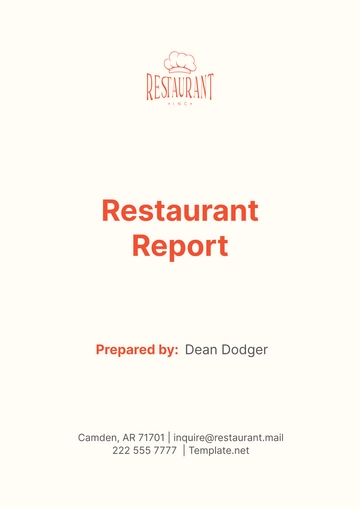Free Restaurant Report
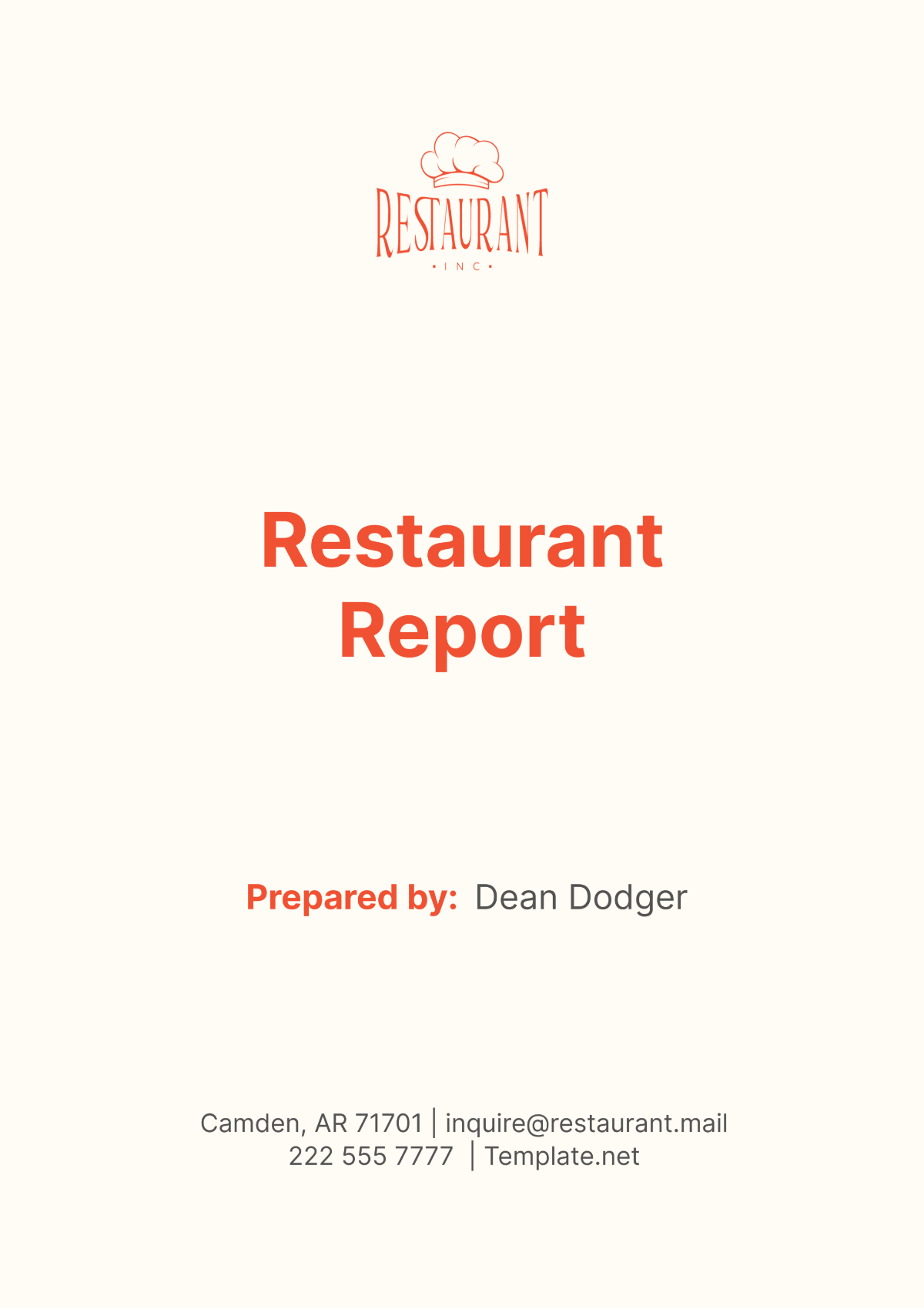
A. Sales Analysis
Welcome to [Your Company Name]'s comprehensive Restaurant Report. This report offers a detailed analysis of our restaurant's performance, operations, and financial health, providing valuable insights to stakeholders. By examining key metrics such as sales, cost of goods sold, labor costs, and customer feedback, this report enables informed decision-making to drive operational efficiency, enhance profitability, and improve the overall dining experience for our patrons.
This Sales Analysis section offers an in-depth breakdown of the restaurant's revenue during the reporting period. By analyzing sales by day, week, month, and category, stakeholders gain valuable insights into performance trends. The following table presents a concise summary of sales data, enabling informed decision-making to optimize operations and profitability.
Period | Total Revenue ($) | Sales by Day ($) | Sales by Week ($) | Sales by Month ($) | Sales by Category ($) |
|---|---|---|---|---|---|
Jan | $[0] | $[0] | $[0] | $[0] | $[0] |
Feb | $[0] | $[0] | $[0] | $[0] | $[0] |
Mar | $[0] | $[0] | $[0] | $[0] | $[0] |
Apr | $[0] | $[0] | $[0] | $[0] | $[0] |
May | $[0] | $[0] | $[0] | $[0] | $[0] |
Jun | $[0] | $[0] | $[0] | $[0] | $[0] |
Jul | $[0] | $[0] | $[0] | $[0] | $[0] |
Aug | $[0] | $[0] | $[0] | $[0] | $[0] |
Sep | $[0] | $[0] | $[0] | $[0] | $[0] |
Oct | $[0] | $[0] | $[0] | $[0] | $[0] |
Nov | $[0] | $[0] | $[0] | $[0] | $[0] |
Dec | $[0] | $[0] | $[0] | $[0] | $[0] |
B. Cost of Goods Sold (COGS)
The Cost of Goods Sold (COGS) section delves into the direct expenses incurred in producing the restaurant's menu items. This analysis encompasses ingredient costs, inventory management, and waste reduction strategies, crucial for maintaining profitability and operational efficiency. The following data offers insights into the distribution of COGS components, aiding in strategic decision-making to optimize resource allocation and enhance cost-effectiveness.
The data highlights the distribution of costs within the Cost of Goods Sold (COGS) framework. Ingredient costs represent the largest portion, accounting for $25,000, indicating a significant expenditure in procuring quality ingredients. Inventory management follows closely at $12,000, reflecting the resources allocated to maintaining optimal inventory levels. Notably, efforts to reduce food waste amount to $8,000, underscoring the restaurant's commitment to sustainability and cost-effective operations. This breakdown informs strategic decision-making to optimize resource allocation and enhance profitability.
C. Labor Cost Analysis
The Labor Cost Analysis section meticulously examines the financial implications of staffing, comprising wages, benefits, and payroll taxes. This scrutiny yields valuable insights into workforce management efficiency, vital for sustaining operational viability and enhancing profitability. The following comprehensive table provides detailed metrics including labor cost percentage, staff scheduling efficiency, and employee productivity, offering an exhaustive portrayal of labor-related expenditures and performance indicators.
Metric | Description | Value (%) or Ratio |
|---|---|---|
Labor Cost Percentage | Proportion of total revenue allocated to labor expenses | [0%] |
Staff Scheduling Efficiency | Measure of how well staffing schedules match operational needs | [0%] |
Employee Productivity | Ratio of output to input, indicating staff efficiency | [0%] |
Wages | Total amount paid to employees for work performed | $[0] |
Benefits | Cost of employee benefits such as healthcare and retirement | $[0] |
Payroll Taxes | Taxes paid by the employer based on employee wages | $[0] |
The detailed labor cost analysis reveals crucial insights into staffing expenditures and performance metrics. With labor cost percentage at [0%], it signifies the portion of total revenue allocated to wages, benefits, and payroll taxes, highlighting the financial impact of workforce management. Staff scheduling efficiency, standing at [0%], indicates the alignment of staffing schedules with operational needs, crucial for optimizing resource utilization. Additionally, employee productivity, at [0%], reflects the effectiveness of labor inputs in generating desired outputs, essential for maximizing operational efficiency and profitability.
D. Profit and Loss Statement (P&L)
The Profit and Loss (P&L) Statement section offers a comprehensive overview of [Your Company Name]'s financial performance, detailing revenues, expenses, and net income (or loss) over the reporting period. This visual representation through a line graph allows stakeholders to easily visualize trends and fluctuations in key financial metrics, facilitating informed decision-making and strategic planning to optimize profitability and ensure financial health.
The line graph illustrates [Your Company Name]'s financial performance over the specified period. Despite fluctuations in revenues and expenses, the consistent net income of $15,000 reflects operational stability and profitability. The upward trend in revenues suggests growing sales, while controlled expenses maintain a healthy bottom line. This steady financial performance indicates effective cost management and revenue growth strategies, positioning the restaurant for continued success.
E. Inventory Management
Tracking the restaurant's inventory levels involves systematically monitoring the quantities of food and non-food items on hand at any given time. This process ensures that [Your Company Name] maintains adequate stock to meet customer demand while minimizing waste and controlling costs. Here's how inventory levels can be tracked:
Regular Physical Counts: Conducting routine physical counts of inventory involves physically counting and recording the quantity of each item in stock. This can be done manually or with the assistance of inventory management software. Physical counts help verify the accuracy of inventory records and identify any discrepancies that may require further investigation.
Inventory Management Software: Utilizing inventory management software can streamline the tracking process by providing real-time visibility into inventory levels. These software solutions often include features such as barcode scanning, automatic reorder alerts, and inventory forecasting to optimize stock levels and reduce the risk of stockouts or overstocking.
Receiving and Requisition Processes: Implementing standardized receiving and requisition processes ensures that inventory levels are accurately recorded as items are received from suppliers and issued for use in the restaurant. Proper documentation of incoming and outgoing inventory transactions helps maintain accurate inventory records and identify any discrepancies or irregularities.
First-In-First-Out (FIFO) Method: Adhering to the FIFO method involves using the oldest inventory items first to minimize the risk of spoilage and ensure product freshness. By rotating inventory based on expiration dates or shelf life, [Your Company Name] can reduce waste and optimize inventory turnover rates.
Inventory Reports and Analysis: Generating inventory reports and conducting regular analysis allows [Your Company Name] to identify trends, track inventory performance metrics, and make data-driven decisions to optimize inventory management practices. These reports may include metrics such as inventory turnover ratios, stockout rates, and inventory carrying costs.
F. Customer Feedback and Reviews
Customer feedback and reviews are invaluable sources of information for [Your Company Name], providing valuable insights into various aspects of the dining experience, including service quality, menu offerings, and overall customer satisfaction. This section aggregates feedback from multiple channels, including customer surveys, online reviews platforms such as Yelp and Google Reviews, and comments on social media platforms like Facebook, Instagram, and Twitter.
Customer Surveys
Conducting customer surveys allows [Your Company Name] to directly solicit feedback from diners about their experiences. Surveys may cover various aspects such as food quality, service speed, cleanliness, ambiance, and overall satisfaction. Analyzing survey responses helps identify areas of strength and areas for improvement, guiding decision-making to enhance the dining experience.
Online Reviews
Monitoring online reviews on platforms like Yelp and Google Reviews provides insights into how customers perceive [Your Company Name]. Review analysis involves assessing the sentiment of reviews, identifying recurring themes or trends, and addressing any concerns or issues raised by customers. Positive reviews highlight strengths to be celebrated, while negative reviews offer opportunities for improvement and service recovery.
Social Media Comments
Engaging with customers on social media platforms allows [Your Company Name] to foster a sense of community and actively participate in conversations about the restaurant. Monitoring and responding to comments, mentions, and direct messages enable [Your Restaurant Name] to address customer inquiries, resolve complaints, and acknowledge positive feedback promptly.
G. Trends and Opportunities
The Trends and Opportunities section delves into the dynamic landscape of the restaurant industry, analyzing emerging trends, market conditions, and potential avenues for growth and improvement. By staying abreast of industry developments and competitive intelligence, [Your Company Name] can capitalize on opportunities to innovate and differentiate itself in the market.
Industry Trends
Identifying and understanding key industry trends allows [Your Company Name] to anticipate changes in consumer preferences and adapt its offerings accordingly. This may include trends related to dietary preferences, dining habits, sustainability initiatives, and technological advancements shaping the restaurant landscape.
Market Conditions
Assessing market conditions provides insights into local economic factors, demographic shifts, and competitive dynamics that may impact [Your Company Name]'s performance. Understanding market demand and consumer behavior enables strategic decision-making to effectively target and attract customers.
Growth and Improvement Opportunities
Based on market analysis and competitive intelligence, this section offers recommendations for menu enhancements, marketing strategies, operational efficiencies, and expansion plans. These recommendations are tailored to capitalize on identified opportunities and address areas for improvement, ultimately driving revenue growth, enhancing customer satisfaction, and maintaining competitiveness in the marketplace.
- 100% Customizable, free editor
- Access 1 Million+ Templates, photo’s & graphics
- Download or share as a template
- Click and replace photos, graphics, text, backgrounds
- Resize, crop, AI write & more
- Access advanced editor
Introducing Template.net's Restaurant Report Template – your comprehensive tool for documenting and analyzing restaurant operations. This editable and customizable template ensures clarity and organization in your reports. Crafted for efficiency, it's editable in our Ai Editor Tool, offering seamless customization. Streamline your restaurant management with detailed reporting and actionable insights.
You may also like
- Sales Report
- Daily Report
- Project Report
- Business Report
- Weekly Report
- Incident Report
- Annual Report
- Report Layout
- Report Design
- Progress Report
- Marketing Report
- Company Report
- Monthly Report
- Audit Report
- Status Report
- School Report
- Reports Hr
- Management Report
- Project Status Report
- Handover Report
- Health And Safety Report
- Restaurant Report
- Construction Report
- Research Report
- Evaluation Report
- Investigation Report
- Employee Report
- Advertising Report
- Weekly Status Report
- Project Management Report
- Finance Report
- Service Report
- Technical Report
- Meeting Report
- Quarterly Report
- Inspection Report
- Medical Report
- Test Report
- Summary Report
- Inventory Report
- Valuation Report
- Operations Report
- Payroll Report
- Training Report
- Job Report
- Case Report
- Performance Report
- Board Report
- Internal Audit Report
- Student Report
- Monthly Management Report
- Small Business Report
- Accident Report
- Call Center Report
- Activity Report
- IT and Software Report
- Internship Report
- Visit Report
- Product Report
- Book Report
- Property Report
- Recruitment Report
- University Report
- Event Report
- SEO Report
- Conference Report
- Narrative Report
- Nursing Home Report
- Preschool Report
- Call Report
- Customer Report
- Employee Incident Report
- Accomplishment Report
- Social Media Report
- Work From Home Report
- Security Report
- Damage Report
- Quality Report
- Internal Report
- Nurse Report
- Real Estate Report
- Hotel Report
- Equipment Report
- Credit Report
- Field Report
- Non Profit Report
- Maintenance Report
- News Report
- Survey Report
- Executive Report
- Law Firm Report
- Advertising Agency Report
- Interior Design Report
- Travel Agency Report
- Stock Report
- Salon Report
- Bug Report
- Workplace Report
- Action Report
- Investor Report
- Cleaning Services Report
- Consulting Report
- Freelancer Report
- Site Visit Report
- Trip Report
- Classroom Observation Report
- Vehicle Report
- Final Report
- Software Report

